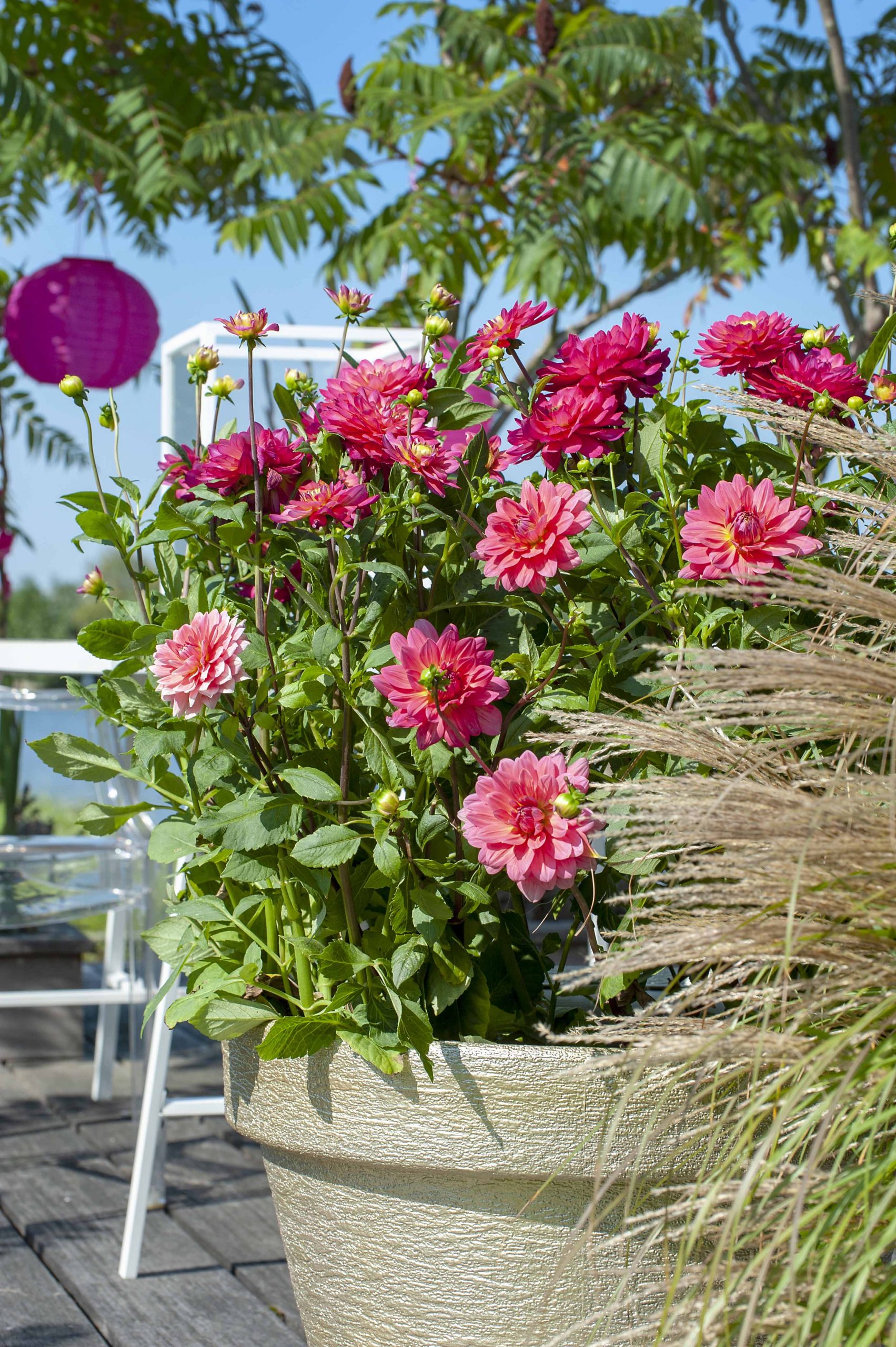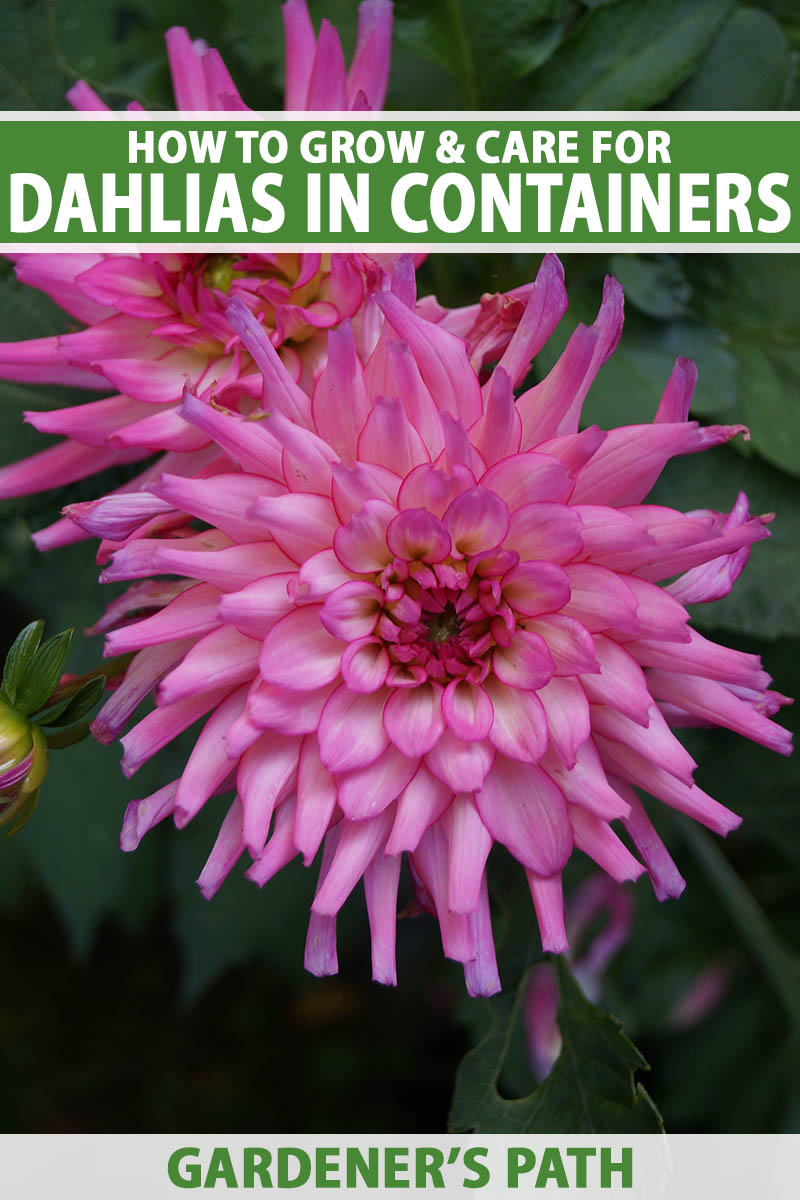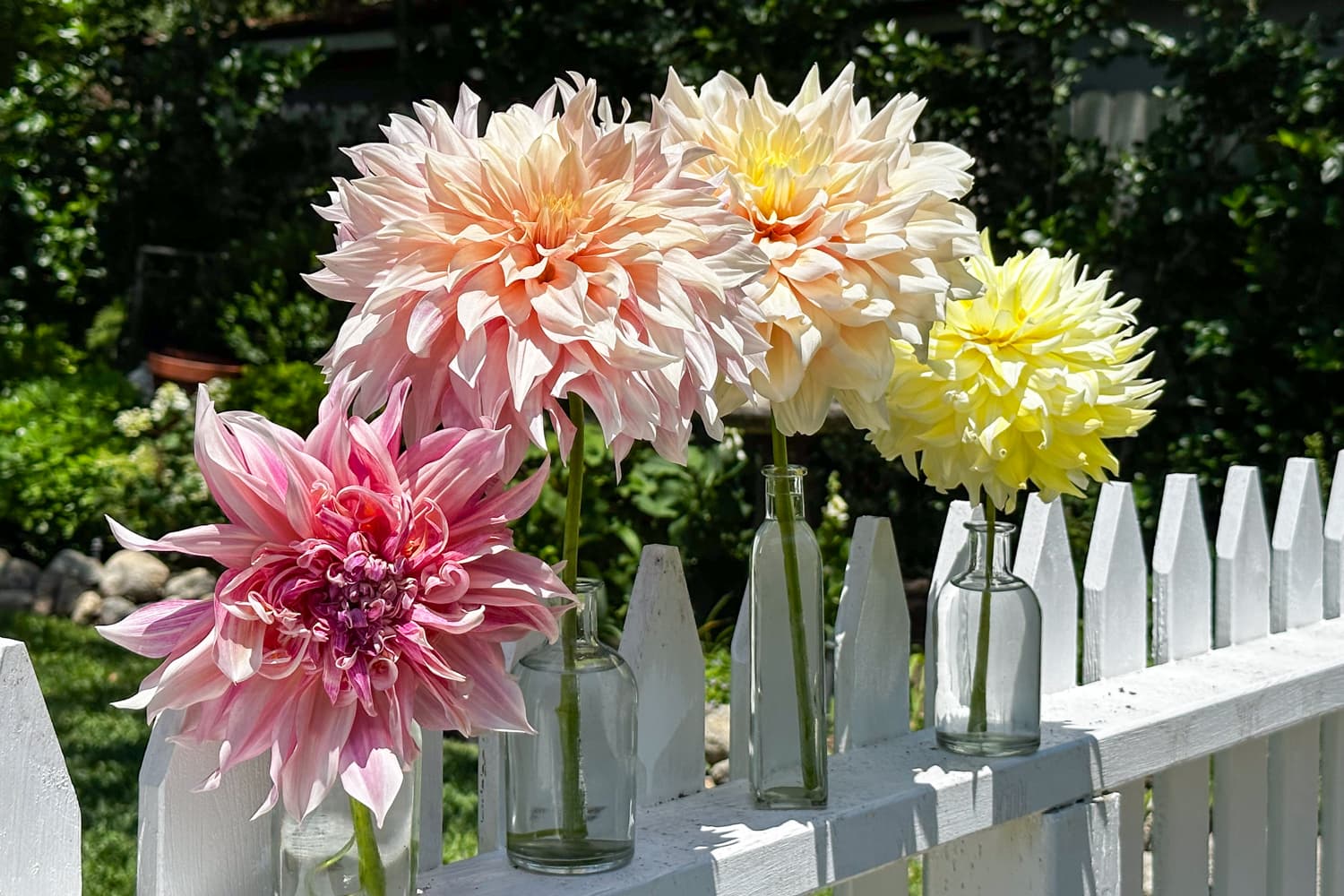Choosing the Right Dahlia Variety for Container Gardening
When it comes to growing dahlias in pots, selecting the right variety is crucial for success. With over 40 species and countless hybrids, choosing the perfect dahlia for container gardening can be overwhelming. However, by considering a few key factors, you can narrow down your options and find the ideal variety for your pots.
One of the most important factors to consider is plant size. Compact or dwarf varieties are ideal for containers, as they require less space and can thrive in smaller pots. Look for varieties that grow to be around 2-3 feet tall, such as ‘Bishop of Llandaff’ or ‘Kelvin Floodlight’. These varieties are perfect for adding a pop of color to small balconies or patios.
Bloom type is another important consideration. If you want to attract pollinators to your container garden, look for varieties with single or semi-double blooms. These blooms are rich in nectar and pollen, making them a favorite of bees and butterflies. ‘Honka’ and ‘Gallery Pablo’ are two popular varieties with single blooms that are perfect for attracting pollinators.
Growth habits are also essential to consider. If you want a variety that will spill over the edges of your pot, look for trailing or cascading varieties. ‘Bishop of York’ and ‘David Howard’ are two popular varieties with a trailing growth habit that are perfect for hanging baskets or containers.
Some popular dahlia varieties that thrive in pots include ‘Cafe au Lait’, ‘Emory Paul’, and ‘Thomas A. Edison’. These varieties offer a range of bloom sizes, colors, and growth habits, making them perfect for adding a unique touch to your container garden.
By considering these factors and choosing the right dahlia variety for your container garden, you can enjoy a bountiful harvest of beautiful blooms all season long. With proper care for dahlias in pots, including providing the right conditions, fertilizing, and deadheading, you can keep your dahlias thriving and enjoy their beauty for months to come.
How to Plant Dahlias in Pots for Optimal Growth
Planting dahlias in pots requires careful attention to detail to ensure optimal growth and blooming. By following these steps, you can give your dahlias the best start in life and enjoy a bountiful harvest of beautiful blooms.
Before planting, prepare the soil by filling the pot with a high-quality potting mix. Dahlias prefer well-draining soil that is rich in organic matter, so consider adding compost or well-rotted manure to the potting mix. If you’re using a container that has been used before, make sure to sterilize it with a solution of one part bleach to nine parts water to prevent the spread of disease.
Select a container that is at least 6-8 inches deep and has drainage holes in the bottom. Dahlias have a deep taproot, so they need a deep pot to accommodate their root system. Make sure the container is also large enough to accommodate the mature size of the plant, taking into account the spread of the foliage and the height of the blooms.
Plant the dahlia tubers in the spring, after the last frost. Plant them 2-4 inches deep, depending on the variety, and space them 12-18 inches apart. Water the soil gently but thoroughly after planting, and keep the soil consistently moist during the first few weeks after planting.
Handle dahlia tubers with care before planting, as they can be easily damaged. Store them in a cool, dark place over the winter, and check on them regularly to make sure they’re not drying out. If you’re planting in the fall, make sure to plant the tubers at least 6-8 weeks before the first frost to give them time to establish themselves before the winter.
By following these steps and providing proper care for dahlias in pots, you can enjoy a thriving and productive plant that will provide you with beautiful blooms all season long. Remember to deadhead regularly, fertilize monthly, and provide support for tall varieties to keep your dahlias looking their best.
Providing the Right Conditions for Dahlias in Pots
Dahlias in pots require specific conditions to thrive, including adequate light, temperature, and watering. By providing the right conditions, you can ensure that your dahlias receive the care they need to produce an abundance of blooms.
Light is one of the most critical factors in growing dahlias in pots. Most dahlia varieties require full sun to partial shade, so choose a location that receives at least 6 hours of direct sunlight per day. However, in warmer climates, it’s essential to provide some shade to prevent scorching of the leaves and flowers.
Temperature is also crucial for dahlias in pots. Most varieties prefer daytime temperatures between 65-75°F (18-24°C) and nighttime temperatures around 55-65°F (13-18°C). Avoid placing pots in areas with extreme temperatures, such as near heating vents or drafty windows.
Watering is another critical aspect of caring for dahlias in pots. Dahlias need consistent moisture, especially when they’re producing buds and blooms. Water your dahlias when the top 1-2 inches of soil feels dry to the touch, and avoid getting water on the leaves or crown to prevent rot and other diseases.
Support is also essential for tall dahlia varieties, which can grow up to 6 feet or more. Use stakes or a trellis to provide support and keep the plant upright, especially in windy or exposed locations. You can also use a tomato cage or a obelisk to provide support and add a decorative element to your pot.
Fertilizing dahlias in pots is also important to promote healthy growth and blooming. Use a balanced fertilizer (10-10-10) and follow the instructions on the label for application rates. You can also use a high-phosphorus fertilizer (10-20-10) to promote blooming and fruiting.
By providing the right conditions, including light, temperature, watering, support, and fertilization, you can ensure that your dahlias in pots receive the care they need to thrive. With proper care for dahlias in pots, you can enjoy a bountiful harvest of beautiful blooms all season long.
Common Challenges When Growing Dahlias in Pots and How to Overcome Them
While growing dahlias in pots can be a rewarding experience, there are several common challenges that may arise. By understanding these challenges and knowing how to overcome them, you can ensure that your dahlias thrive and produce an abundance of blooms.
Pests are one of the most common problems when growing dahlias in pots. Aphids, whiteflies, and spider mites are all common pests that can infest dahlias. To prevent pest infestations, use neem oil or insecticidal soap to control pests. You can also introduce beneficial insects, such as ladybugs or lacewings, to your pot to help control pest populations.
Diseases are another common challenge when growing dahlias in pots. Powdery mildew, leaf spot, and root rot are all common diseases that can affect dahlias. To prevent diseases, make sure to provide good air circulation around your pot, and avoid getting water on the leaves or crown. You can also use fungicides to control diseases.
Nutrient deficiencies are also a common problem when growing dahlias in pots. Dahlias require a balanced fertilizer to produce healthy growth and blooms. Use a balanced fertilizer (10-10-10) and follow the instructions on the label for application rates. You can also use a high-phosphorus fertilizer (10-20-10) to promote blooming and fruiting.
Overwatering is another common challenge when growing dahlias in pots. Dahlias require consistent moisture, but overwatering can lead to root rot and other problems. Make sure to check the soil regularly, and avoid getting water on the leaves or crown.
Underwatering is also a common problem when growing dahlias in pots. Dahlias require consistent moisture, especially when they’re producing buds and blooms. Make sure to water your dahlias regularly, and avoid letting the soil dry out completely.
By understanding these common challenges and knowing how to overcome them, you can ensure that your dahlias thrive and produce an abundance of blooms. With proper care for dahlias in pots, you can enjoy a bountiful harvest of beautiful blooms all season long.
Deadheading and Pruning Dahlias in Pots for More Blooms
Deadheading and pruning are essential techniques for encouraging more blooms and maintaining plant shape when growing dahlias in pots. By removing spent flowers and pruning back the stems, you can promote healthy growth and encourage your dahlias to produce more blooms.
Deadheading involves removing the spent flowers from the plant, which helps to encourage the dahlia to produce more blooms. To deadhead your dahlias, simply snip off the spent flower at the base of the stem, making sure to leave the stem intact. This will help the plant to focus its energy on producing new blooms rather than seed production.
Pruning is also an important technique for maintaining plant shape and encouraging more blooms. Dahlias can grow quite tall, so pruning back the stems can help to keep the plant bushy and compact. To prune your dahlias, simply cut back the stems to about one-third of their height, making sure to leave at least two sets of leaves on the stem. This will help the plant to produce new growth and encourage more blooms.
When pruning dahlias, it’s also important to remove any weak or spindly growth. This will help to promote healthy growth and prevent the plant from becoming leggy. Simply snip off any weak or spindly stems at the base, making sure to leave the stronger stems intact.
Timing is also important when it comes to deadheading and pruning dahlias. It’s best to deadhead and prune your dahlias in the morning, when the plant is at its highest water content. This will help to prevent the plant from becoming stressed and will promote healthy growth.
By deadheading and pruning your dahlias regularly, you can encourage more blooms and maintain plant shape. With proper care for dahlias in pots, including deadheading and pruning, you can enjoy a bountiful harvest of beautiful blooms all season long.
Winter Care for Dahlias in Pots: Tips for Overwintering
As the weather starts to cool down, it’s essential to provide proper winter care for dahlias in pots to ensure their survival. Dahlias are sensitive to frost, so they need to be protected from extreme temperatures to prevent damage or death.
One of the most critical steps in overwintering dahlias in pots is to cut back the foliage. This will help to prevent the plant from putting energy into producing new growth, which can make it more susceptible to damage from frost. Cut back the stems to about 6-8 inches from the ground, and remove any dead or damaged leaves.
Next, store the tubers in a cool, dark place. Dahlias can be stored in a variety of containers, including paper bags, cardboard boxes, or plastic containers. Make sure the container is well-ventilated and has drainage holes to prevent moisture from building up.
Before storing the tubers, make sure to clean them thoroughly to remove any dirt or debris. This will help to prevent the spread of disease and encourage healthy growth in the spring.
Another essential step in overwintering dahlias in pots is to protect the containers from extreme temperatures. If you live in an area with harsh winters, consider moving the containers to a protected location, such as a garage or shed. If this isn’t possible, wrap the containers in a layer of insulation, such as bubble wrap or foam, to protect them from frost.
It’s also essential to keep the soil moist during the winter months. Dahlias need consistent moisture to survive, so make sure to water the soil occasionally to keep it from drying out.
By following these tips, you can ensure that your dahlias in pots survive the winter and come back strong in the spring. With proper care for dahlias in pots, including overwintering, you can enjoy a bountiful harvest of beautiful blooms for years to come.
Pest and Disease Management for Dahlias in Pots
When growing dahlias in pots, it’s essential to be aware of the common pests and diseases that can affect them. By taking proactive steps to prevent and manage these issues, you can ensure that your dahlias remain healthy and thrive.
Aphids are one of the most common pests that can affect dahlias in pots. These small, soft-bodied insects can cause curled or distorted leaves, and can also spread plant viruses. To control aphids, use neem oil or insecticidal soap, and make sure to spray the undersides of the leaves where aphids tend to congregate.
Slugs are another common pest that can affect dahlias in pots. These slimy creatures can cause holes in the leaves and flowers, and can also spread disease. To control slugs, use copper tape or crushed eggshells around the perimeter of the pot, and make sure to hand-pick any slugs that you find.
Powdery mildew is a common disease that can affect dahlias in pots. This fungal disease can cause a white, powdery coating to form on the leaves, and can also cause the leaves to become distorted or discolored. To control powdery mildew, use a fungicide specifically designed for powdery mildew, and make sure to remove any infected leaves or stems.
Other common pests and diseases that can affect dahlias in pots include spider mites, mealybugs, and root rot. To prevent these issues, make sure to provide good air circulation around the pot, and avoid overwatering or underwatering the soil.
Organic control methods are also available for managing pests and diseases in dahlias in pots. These methods include using natural predators, such as ladybugs or lacewings, to control pests, and using natural fungicides, such as garlic or cinnamon, to control diseases.
By being aware of the common pests and diseases that can affect dahlias in pots, and taking proactive steps to prevent and manage these issues, you can ensure that your dahlias remain healthy and thrive. With proper care for dahlias in pots, including pest and disease management, you can enjoy a bountiful harvest of beautiful blooms all season long.
Propagation and Division of Dahlias in Pots
Propagation and division are essential techniques for increasing your dahlia stock and sharing plants with friends. By learning how to propagate and divide dahlias in pots, you can enjoy a bountiful harvest of beautiful blooms for years to come.
Taking cuttings is one of the most common methods of propagating dahlias in pots. To take cuttings, simply snip off a section of stem from the mother plant, making sure to leave at least two sets of leaves on the cutting. Remove any lower leaves that will be submerged in water, and place the cutting in a glass of water or a propagation tray filled with water.
Dividing tubers is another method of propagating dahlias in pots. To divide tubers, simply dig up the tubers in the fall, after the first frost, and separate them into individual tubers. Make sure to handle the tubers carefully, as they can be easily damaged. Replant the tubers in the spring, after the last frost, and water well.
Growing dahlias from seed is also a viable option for propagation. To grow dahlias from seed, simply sow the seeds indoors 6-8 weeks before the last frost, and transplant them outside after the last frost. Make sure to provide adequate light and water, and fertilize regularly.
When propagating and dividing dahlias in pots, it’s essential to provide the right conditions for growth. Make sure to provide adequate light, water, and fertilizer, and keep the soil consistently moist. With proper care for dahlias in pots, including propagation and division, you can enjoy a bountiful harvest of beautiful blooms for years to come.
By learning how to propagate and divide dahlias in pots, you can share plants with friends and family, and enjoy a bountiful harvest of beautiful blooms for years to come. With proper care for dahlias in pots, including propagation and division, you can master the art of container dahlias and enjoy a beautiful and thriving garden.









